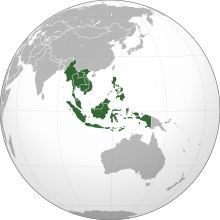
Back Asia Teunggara ACE Suidoos-Asië Afrikaans Südostasien ALS ደቡብ-ምስራቅ እስያ Amharic جنوب شرق آسيا Arabic تصنيف:حيوانات د جنوب شرق آسيا ARY Sureste asiáticu AST Geronefa Asia AVK Cənub-Şərqi Asiya Azerbaijani جنوبشرقی آسیا AZB
Southeast Asia[d] is the geographical southeastern region of Asia, consisting of the regions that are situated south of China, east of the Indian subcontinent, and northwest of the Australian mainland, which is part of Oceania.[5] Southeast Asia is bordered to the north by East Asia, to the west by South Asia and the Bay of Bengal, to the east by Oceania and the Pacific Ocean, and to the south by Australia and the Indian Ocean. Apart from the British Indian Ocean Territory and two out of 26 atolls of the Maldives in South Asia, Maritime Southeast Asia is the only other subregion of Asia that lies partly within the Southern Hemisphere. Mainland Southeast Asia is entirely in the Northern Hemisphere. East Timor and the southern portion of Indonesia are the parts of Southeast Asia that lie south of the equator.
The region lies near the intersection of geological plates, with both heavy seismic and volcanic activities.[6] The Sunda Plate is the main plate of the region, featuring almost all Southeast Asian countries except Myanmar, northern Thailand, northern Laos, northern Vietnam, and northern Luzon of the Philippines, while the Sunda Plate only includes western Indonesia to as far east as the Indonesian province of Bali. The mountain ranges in Myanmar, Thailand, Peninsular Malaysia, and the Indonesian islands of Sumatra, Java, Bali, Lesser Sunda Islands, and Timor are part of the Alpide belt, while the islands of the Philippines and Indonesia as well as East Timor are part of the Pacific Ring of Fire. Both seismic belts meet in Indonesia, causing the region to have relatively high occurrences of earthquakes and volcanic eruptions, particularly in the Philippines and Indonesia.[7]
It covers about 4,500,000 km2 (1,700,000 sq mi), which is 8% of Eurasia and 3% of Earth's total land area. Its total population is more than 675 million, about 8.5% of the world's population. It is the third most populous geographical region in Asia after South Asia and East Asia.[8] The region is culturally and ethnically diverse, with hundreds of languages spoken by different ethnic groups.[9] Ten countries in the region are members of the Association of Southeast Asian Nations (ASEAN), a regional organisation established for economic, political, military, educational, and cultural integration among its members.[10]
Southeast Asia is one of the most culturally diverse regions of the world. There are many different languages and ethnicities in the region. Historically, Southeast Asia was significantly influenced by Indian, Chinese, Muslim, and colonial cultures, which became core components of the region's cultural and political institutions. Most modern Southeast Asian countries were colonised by European powers. European colonisation exploited natural resources and labour from the lands they conquered, and attempted to spread European institutions to the region.[11] Several Southeast Asian countries were also briefly occupied by the Japanese Empire during World War II. The aftermath of World War II saw most of the region decolonised. Today, Southeast Asia is predominantly governed by independent states.[12]
- ^ "World Population Prospects 2022". United Nations Department of Economic and Social Affairs, Population Division. Retrieved 17 July 2022.
- ^ "World Population Prospects 2022: Demographic indicators by region, subregion and country, annually for 1950-2100" (XSLX) ("Total Population, as of 1 July (thousands)"). United Nations Department of Economic and Social Affairs, Population Division. Retrieved 17 July 2022.
- ^ ASEAN Community in Figures (ACIF) 2013 (PDF) (6th ed.). Jakarta: ASEAN. February 2014. p. 1. ISBN 978-602-7643-73-4. Archived from the original (PDF) on 4 September 2015. Retrieved 9 May 2015.
- ^ a b Cite error: The named reference
IMFwas invoked but never defined (see the help page). - ^ Klaus Kästle (10 September 2013). "Map of Southeast Asia Region". Nations Online Project. One World – Nations Online. Archived from the original on 20 September 2013. Retrieved 10 September 2013.
Southeast Asia is a vast subregion of Asia, roughly described as geographically situated east of the Indian subcontinent, south of China, and northwest of Australia. The region is located between the Indian Ocean and the Bay of Bengal in the west, the Philippine Sea, the South China Sea, and the Pacific Ocean in the east.
- ^ Whelley, Patrick L.; Newhall, Christopher G.; Bradley, Kyle E. (2015). "The frequency of explosive volcanic eruptions in Southeast Asia". Bulletin of Volcanology. 77 (1): 1. Bibcode:2015BVol...77....1W. doi:10.1007/s00445-014-0893-8. ISSN 0258-8900. PMC 4470363. PMID 26097277.
- ^ Chester, Roy (16 July 2008). Furnace of Creation, Cradle of Destruction: A Journey to the Birthplace of Earthquakes, Volcanoes, and Tsunamis. AMACOM. ISBN 978-0-8144-0920-6.
- ^ "Population of Asia (2018)". worldometers.info. Archived from the original on 6 January 2019. Retrieved 30 December 2018.
- ^ Zide; Baker, Norman H.; Milton E. (1966). Studies in comparative Austroasiatic linguistics. Foreign Language Study.
{{cite book}}: CS1 maint: multiple names: authors list (link) - ^ "ASEAN Member States". ASEAN. Archived from the original on 10 August 2019. Retrieved 27 August 2017.
- ^ "The economic impact of colonialism". CEPR. 30 January 2017.
- ^ Paseng, Rohayati. "Research Guides: Southeast Asia Research Guide: Imperialism, Colonialism, & Nationalism". guides.library.manoa.hawaii.edu. Archived from the original on 9 July 2022. Retrieved 9 July 2022.
Cite error: There are <ref group=lower-alpha> tags or {{efn}} templates on this page, but the references will not show without a {{reflist|group=lower-alpha}} template or {{notelist}} template (see the help page).
Cite error: There are <ref group=note> tags on this page, but the references will not show without a {{reflist|group=note}} template (see the help page).
